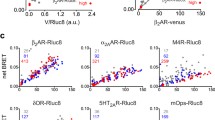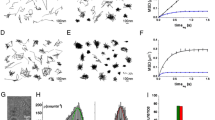Abstract
It is now well established that rhodopsin-like, family-AG protein-coupled receptors (GPCRs) can exist within homo- and heterodimeric/oligomeric complexes. However, limited information is currently available on the molecular basis of these interactions or their selectivity. Using the α1-adrenoceptor family as a model, this has been examined using assays including coimmunoprecipitation, saturation biluminescence resonance energy transfer (BRET), time-resolved fluorescence resonance energy transfer (FRET), and bimolecular fluorescence complementation. We demonstrate key roles for transmembrane helices I and IV in homodimeric/oligomeric interactions of the α1b-adrenoceptor and suggest that other interactions indicate that this GPCR can exist as a higher-order oligomeric complex. Literature reports on heterodimerization between chemokine receptor family members and the effects or otherwise of agonist ligands are complex. It was recently indicated that although the CXCR2 receptor is able to homodimerize, this is not the case for the closely related CXCR1 receptor and that these two GPCRs do not heterodimerize. We have reinvestigated these issues using combinations of coimmunoprecipitation, saturation BRET, and novel endoplasmic reticulum-trapping strategy. Unlike the previous report, we demonstrate that CXCR1 is able to both homodimerize and heterodimerize with the CXCR2 receptor and that the relative affinity of these interactions suggests that with coexpression of these two GPCRs a random mixture of homo- and heterodimers will be present.
Similar content being viewed by others
References
Angers S., Salahpour A., and Bouvier M. (2002) Dimerization: an emerging concept for G protein-coupled receptor ontogeny and function. Annu. Rev. Pharmacol. Toxicol. 42, 409–435.
Baneres J. L. and Parello J. (2003) Structure-based analysis of GPCR function: evidence for a novel pentameric assembly between the dimeric leukotriene B4 receptor BLT1 and the G-protein. J. Mol. Biol. 329, 815–829.
Brady A. E. and Limbird L. E. (2002) G protein-coupled receptor interacting proteins: emerging roles in localization and signal transduction. Cell Signal. 14, 297–309.
Carrillo J. J., López-Gimenez J. F., and Milligan G. (2004) Multiple interactions between transmembrane helices generate the oligomeric α1b-adrenoceptor. Mol. Pharmacol. 66, 1123–1137.
Carrillo J. J., Pediani J., and Milligan G. (2003) Dimers of class A G protein-coupled receptors function via agonist-mediated trans-activation of associated G proteins. J. Biol. Chem. 278, 42578–42587.
Coge F., Guenin S. P., Renouard-Try A., Rique H., Ouvry C., Fabry N., et al. (1999) Truncated isoforms inhibit [3H]prazosin binding and cellular trafficking of native human alpha1A-adrenoceptors. Biochem. J. 343, 231–239.
George S. R., O’Dowd B. F., and Lee S. P. (2002) G-protein-coupled receptor oligomerization and its potential for drug discovery. Nat. Rev. Drug Discovery 1, 808–820.
Guo W., Shi L., and Javitch J. A. (2003) The fourth transmembrane segment forms the interface of the dopamine D2 receptor homodimer. J. Biol. Chem. 278, 4385–4388.
Hakak Y., Shrestha D., Goegel M. C., Behan D. P., and Chalmers D. T. (2003) Global analysis of G-protein-coupled receptor signaling in human tissues. FEBS Lett. 550, 11–17.
Hernanz-Falcon P., Rodriguez-Frade J. M., Serrano A., Juan D., del Sol A., Soriano S. F., et al. (2004) Identification of amino acid residues crucial for chemokine receptor dimerization. Nat. Immunol. 5, 216–223.
Klco J. M., Lassere T. B., and Baranski T. J. (2003) C5a receptor oligomerization. I. Disulfide trapping reveals oligomers and potential contact surfaces in a G protein-coupled receptor. J. Biol. Chem. 278, 35345–35353.
Koshimizu T. A., Tanoue A., Hirasawa A., Yamauchi J., and Tsujimoto G. (2003) Recent advances in alpha1-adrenoceptor pharmacology. Pharmacol. Ther. 98, 235–244.
Lee S. P., O’Dowd B. F., Rajaram R. D., Nguyen T., and George S. R. (2003) D2 dopamine receptor homodimerization is mediated by multiple sites of interaction, including an intermolecular interaction involving transmembrane domain 4. Biochemistry 42, 11023–11031.
Liang Y., Fotiadis D., Filipek S., Saperstein D. A., Palczewski K., and Engel A. (2003) Organization of the G protein-coupled receptors rhodopsin and opsin in native membranes. J. Biol. Chem. 278, 21655–21662.
Margeta-Mitrovic M. (2002) Assembly-dependent trafficking assays in the detection of receptor-receptor interactions. Methods 27, 311–317.
Mercier J. F., Salahpour A., Angers S., Breit A., and Bouvier M. (2002) Quantitative assessment of beta 1- and beta 2-adrenergic receptor homo- and heterodimerization by bioluminescence resonance energy transfer. J. Biol. Chem. 277, 44925–44931.
Milligan G. (2004) G protein-coupled receptor dimerization: function and ligand pharmacology. Mol. Pharmacol. 66, 1–7.
Milligan G. and White J. H. (2001) Protein-protein interactions at G-protein-coupled receptors. Trends Pharmacol. Sci. 22, 513–518.
Milligan G., Lopez-Gimenez J. F., Wilson S., and Carrillo J. (2004) Selectivity in the oligomerisation of G protein-coupled receptors. Semin. Cell Develop. Biol. 15, 263–268.
Morris D. P., Price R. R., Smith M. P., Lei B., and Schwinn D. A. (2004) Cellular trafficking of human 1a-adrenergic receptors is continuous and primarily agonist-independent. Mol. Pharmacol. 66, 843–854.
Piascik M. T. and Perez D. M. (2001) Alpha1-adrenergic receptors: new insights and directions. J. Pharmacol. Exp. Ther. 298, 403–410.
Ramsay D., Carr I. C., Pediani J., Lopez-Gimenez J. F., Thurlow R., Fidock M., and Milligan G. (2004) High affinity interactions between human α1A-adrenoceptor C-terminal splice variants produce homo and heterodimers but do not generate the α1L-adrenoceptor. Mol. Pharmacol. 66, 228–239.
Ramsay D., Kellett E., McVey M., Rees S., and Milligan G. (2002) Homo- and hetero-oligomeric interactions between G-protein-coupled receptors in living cells monitored by two variants of bioluminescence resonance energy transfer (BRET): hetero-oligomers between receptor subtypes form more efficiently than between less closely related sequences. Biochem. J. 365, 429–440.
Rodriguez-Frade J. M., Mellado M., and Martinez A.C. (2001) Chemokine receptor dimerization: two are better than one. Trends Immunol. 22, 612–617.
Salahpour A., Angers S., Mercier J. F., Lagace M., Marullo S., and Bouvier M. (2004) Homodimerization of the beta 2-adrenergic receptor as a pre-requisite for cell surface targeting. J. Biol. Chem. 279, 33390–33397.
Schwappach B., Zerangue N., Jan Y. N., and Jan L. Y. (2000) Molecular basis for K(ATP) assembly: transmembrane interactions mediate association of a K+ channel with an ABC transporter. Neuron 26, 155–167.
Stanasila L., Perez J.-B., Vogel H., and Cotecchia S. (2003) Oligomerization of the α1a- and α1b-adrenergic receptor subtypes. J. Biol. Chem. 278, 40239–40251.
Trettel F., Di Bartolomeo.S., Lauro C., Catalano M., Ciotti M. T., and Limatola C. (2003) Ligand-independent CXCR2 dimerization. J. Biol. Chem. 278, 40980–40988.
Uberti M. A., Hall R. A., and Minneman K. P. (2003) Subtype-specific dimerization of alpha 1-adrenoceptors: effects on receptor expression and pharmaco-logical properties. Mol. Pharmacol. 64, 1379–1390.
Author information
Authors and Affiliations
Corresponding author
Rights and permissions
About this article
Cite this article
Milligan, G., Wilson, S. & López-Gimenez, J.F. The specificity and molecular basis of α1-adrenoceptor and CXCR chemokine receptor dimerization. J Mol Neurosci 26, 161–168 (2005). https://doi.org/10.1385/JMN:26:2-3:161
Issue Date:
DOI: https://doi.org/10.1385/JMN:26:2-3:161




